Back in June, Macromedia started talking publicly about their ambitious plans for Flash. It’s clear that they’re planning to take it up a few gears on all fronts; the creation; the server; and the player side.
For us, the big news is the updating of the video CoDec, taking it from the old H.283 CoDec of the previous release to On2 Technologies, VP6. Both are claiming better performance than Windows Media, with a 10-20% size reduction over it too.
High-quality video running in Flash could be a serious contender to Apple, Real and Microsoft. The Flash player is thought to be installed on 98% of all computers, totalling about 600 million machines.
While some of those involved in producing video for the Web might see this and groan – encoding video in each of the three dominant formats was often seen as a major headache – it could be that Flash could cut across that problem.
For a long time many have thought that Flash could become a dominant development platform, delivering what Java promised and failed to achieve – write once, play anywhere.
As Flash is vector-based, not bit-mapped – its graphics are described in terms of shapes, not absolute positions on a screen – it has the strength that the displays scale. This is of particular benefit when writing applications for mobile phones which have hundreds of variation of screen size and resolution across the market.
Developers of mobile phone content find themselves having to write hundreds of different versions of a programme, if they want to support the whole market.
The rumours a flying as to when Flash 8 might be released. The official word is ‘Summer’, but some are speculating that it might be 8/8, 8th August.
Making the most of the interest that is bound to be heading in their direction, this week On2 have released a new version of their encoding tool, VP7.
On2 Technologies
MacroMedia
Flashmagazine – Interview with Doug McIntyre from On2 Technologies
 MTV is in the mood to get all interactive with its audience with the launch of MTV: starzine, a new online magazine designed to give “music wannabies the opportunity to realise their dreams of becoming an MTV star.”
MTV is in the mood to get all interactive with its audience with the launch of MTV: starzine, a new online magazine designed to give “music wannabies the opportunity to realise their dreams of becoming an MTV star.” In another cunning ploy to keep users coming back for more, users will earn points for interacting with the magazine and the more material they shunt online and the bigger the audience, the more points they amass.
In another cunning ploy to keep users coming back for more, users will earn points for interacting with the magazine and the more material they shunt online and the bigger the audience, the more points they amass. The all-blinking, Flash-tastic, David Carson ‘tribute’ site lets users upload unlimited images as well as text on to the magazine, with the facility to directly submit photographs taken on a cameraphone.
The all-blinking, Flash-tastic, David Carson ‘tribute’ site lets users upload unlimited images as well as text on to the magazine, with the facility to directly submit photographs taken on a cameraphone.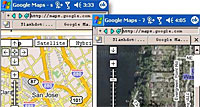 The Mozilla Foundation has released a technology preview of a mobile-phone browser, based on the same code that powers the popular Firefox browser.
The Mozilla Foundation has released a technology preview of a mobile-phone browser, based on the same code that powers the popular Firefox browser.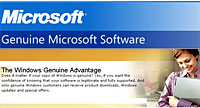 Hackers have made chumps out of Microsoft, successfully bypassing their Windows Genuine Advantage (WGA) Programme only days after the anti-piracy scheme was activated.
Hackers have made chumps out of Microsoft, successfully bypassing their Windows Genuine Advantage (WGA) Programme only days after the anti-piracy scheme was activated. Figures from the Mobile Data Association (MDA) reveal that U.K. mobile phone users sent an astonishing 2.6 billion text messages in June.
Figures from the Mobile Data Association (MDA) reveal that U.K. mobile phone users sent an astonishing 2.6 billion text messages in June. FinePix S9000 Zoom
FinePix S9000 Zoom The compact-based design means that – unlike dSLRs – the camera can offer 30-frames-per-second movie mode (with a manual zoom capability) – something that may prove tempting to punters after a high quality ‘do it all’ camera.
The compact-based design means that – unlike dSLRs – the camera can offer 30-frames-per-second movie mode (with a manual zoom capability) – something that may prove tempting to punters after a high quality ‘do it all’ camera. Second up is the Fujifilm FinePix S5200 Zoom, the third incarnation of Fujifilm’s S series cameras.
Second up is the Fujifilm FinePix S5200 Zoom, the third incarnation of Fujifilm’s S series cameras.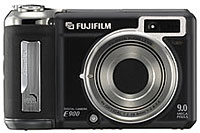 Finally, we come to the Fujifilm FinePix E900 Zoom, a new E series “pocket friendly” compact managing to pack 9 million effective pixels into its lithe proportions.
Finally, we come to the Fujifilm FinePix E900 Zoom, a new E series “pocket friendly” compact managing to pack 9 million effective pixels into its lithe proportions. Online broadband film distributer, and latterly video content provider CinemaNow, has announced that they will be carrying some high-definition from HDNet on their Internet to PC delivery platform. It’s the first time that HDNet’s content has been made available on-demand through an online broadband service.
Online broadband film distributer, and latterly video content provider CinemaNow, has announced that they will be carrying some high-definition from HDNet on their Internet to PC delivery platform. It’s the first time that HDNet’s content has been made available on-demand through an online broadband service. Mark Cuban, the CEO of HDNet, has been slowly gathering HD content to the point where HDNet now lay claim to having more original high-definition content than any other network. We at Digital-Lifestyles.info have had our eye on him for years, as we think he’s a smart cookie. He not only spots upcoming trends, but turns them into businesses. He made a fortune when he sold broadcast.com to Yahoo for billions of dollars at the peak of the market.
Mark Cuban, the CEO of HDNet, has been slowly gathering HD content to the point where HDNet now lay claim to having more original high-definition content than any other network. We at Digital-Lifestyles.info have had our eye on him for years, as we think he’s a smart cookie. He not only spots upcoming trends, but turns them into businesses. He made a fortune when he sold broadcast.com to Yahoo for billions of dollars at the peak of the market. Following a long tradition of The Man stealing ideas off the street to flog their products, T-Mobile is organising a series of impromptu ‘street gigs’ to promote their new Sony Ericsson D750i camera phone.
Following a long tradition of The Man stealing ideas off the street to flog their products, T-Mobile is organising a series of impromptu ‘street gigs’ to promote their new Sony Ericsson D750i camera phone. Keen to milk every last ounce of PR potential from the gigs, T-Mobile will be broadcasting the performances online, with company bods on hand to encourage T-Mobile subscribers to test the new handset
Keen to milk every last ounce of PR potential from the gigs, T-Mobile will be broadcasting the performances online, with company bods on hand to encourage T-Mobile subscribers to test the new handset  “T-Mobile Street Gigs is the first of our new initiatives to deliver unique experiences for customers,” grooved Phil Chapman, UK marketing director, loosening his tie and turning down the David Gray.
“T-Mobile Street Gigs is the first of our new initiatives to deliver unique experiences for customers,” grooved Phil Chapman, UK marketing director, loosening his tie and turning down the David Gray. Amazon.com’s revenue soared internationally in the second quarter as electronics and other non-book bits’n’bobs made up more of its business.
Amazon.com’s revenue soared internationally in the second quarter as electronics and other non-book bits’n’bobs made up more of its business. Amazon.com’s chief financial officer, Tom Szkutak, announced that third-party sales accounted for 28 percent of Amazon.com’s total items sold, sprightly stepping up from 24 percent for this time last year.
Amazon.com’s chief financial officer, Tom Szkutak, announced that third-party sales accounted for 28 percent of Amazon.com’s total items sold, sprightly stepping up from 24 percent for this time last year. This includes US$56 million (~£32.25m, ~€46.6m) in income tax expense, which was up from US$5 million (~£2.87m, ~€4.16m) a year earlier.
This includes US$56 million (~£32.25m, ~€46.6m) in income tax expense, which was up from US$5 million (~£2.87m, ~€4.16m) a year earlier.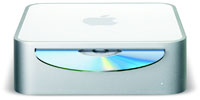 Apple Computer has unveiled updates to its iBook laptop and Mac Mini lines, lobbing in new features, more memory and built in wireless technology – although the anticipated widescreen models failed to run up at the launch party.
Apple Computer has unveiled updates to its iBook laptop and Mac Mini lines, lobbing in new features, more memory and built in wireless technology – although the anticipated widescreen models failed to run up at the launch party.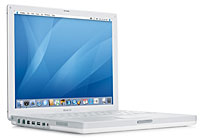 The new iBook G4s now come with a faster Power PC G4 processor running up to 1.42 GHz, with 512MB memory as standard, higher performance graphics and built-in AirPort Extreme and Bluetooth wireless connectivity.
The new iBook G4s now come with a faster Power PC G4 processor running up to 1.42 GHz, with 512MB memory as standard, higher performance graphics and built-in AirPort Extreme and Bluetooth wireless connectivity.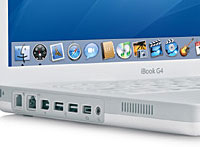 The 1.33 GHz PowerPC with 12″ screen G4 iBook retails at £699/US$999 and its bigger 1.42 GHz PowerPC G4 iBook with 14″ display knocks out for £899/US$1299.
The 1.33 GHz PowerPC with 12″ screen G4 iBook retails at £699/US$999 and its bigger 1.42 GHz PowerPC G4 iBook with 14″ display knocks out for £899/US$1299.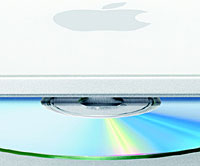 The diminutive Mac Mini range features three new models – the 1.25 GHz Mac Mini, 1.42 GHz Mac mini and the new 1.42 GHz Mac Mini with SuperDrive – with memory upgraded to 512 MB throughout.
The diminutive Mac Mini range features three new models – the 1.25 GHz Mac Mini, 1.42 GHz Mac mini and the new 1.42 GHz Mac Mini with SuperDrive – with memory upgraded to 512 MB throughout. Illegal music downloaders shell out more for legitimate music downloads than goody two-shoes music fans.
Illegal music downloaders shell out more for legitimate music downloads than goody two-shoes music fans.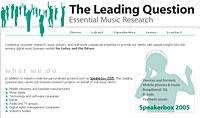 How much both groups spend on CDs wasn’t specified.
How much both groups spend on CDs wasn’t specified.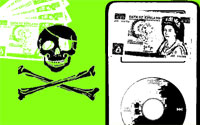 Respondents cited built-in cameras, organiser functions and video cameras above music players in their preferences for mobile phone features.
Respondents cited built-in cameras, organiser functions and video cameras above music players in their preferences for mobile phone features. As part of Motorola’s strategy to tempt home and business with new services, the company has announced that it will add Yahoo! Web services to their Linux-based mobile devices.
As part of Motorola’s strategy to tempt home and business with new services, the company has announced that it will add Yahoo! Web services to their Linux-based mobile devices. Ron Garriques, president of Motorola’s mobile device business, said: “By optimising these products for our leading Linux and Java software platform, we’re making it just that much easier for operators to maximize revenue while delivering the most innovative consumer experiences.”
Ron Garriques, president of Motorola’s mobile device business, said: “By optimising these products for our leading Linux and Java software platform, we’re making it just that much easier for operators to maximize revenue while delivering the most innovative consumer experiences.” Elsewhere, the company have also announced that Vonage will offer the new Motorola VT2442 voice over Internet Protocol (VoIP) gateway to its Internet telephony customers.
Elsewhere, the company have also announced that Vonage will offer the new Motorola VT2442 voice over Internet Protocol (VoIP) gateway to its Internet telephony customers.